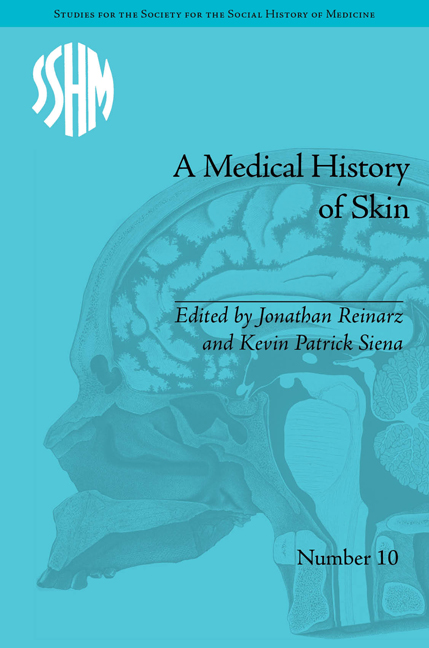Book contents
- Frontmatter
- CONTENTS
- List of Contributors
- List of Figures and Tables
- Scratching the Surface: An Introduction
- Part I The Emerging Skin Field
- Part II Skin, Stigma and Identity
- Part III Skin, Disease and Visual Culture
- Afterword: Reading the Skin, Discerning the Landscape: A Geo-historical Perspective of our Human Surface
- Notes
- Index
Afterword: Reading the Skin, Discerning the Landscape: A Geo-historical Perspective of our Human Surface
- Frontmatter
- CONTENTS
- List of Contributors
- List of Figures and Tables
- Scratching the Surface: An Introduction
- Part I The Emerging Skin Field
- Part II Skin, Stigma and Identity
- Part III Skin, Disease and Visual Culture
- Afterword: Reading the Skin, Discerning the Landscape: A Geo-historical Perspective of our Human Surface
- Notes
- Index
Summary
Contributors to this volume frequently alluded to ways of perceiving the skin beyond that of a mere bodily part or a platform for disease. Many of these perceptions bear a striking similarity to geo-history. Geo-history depicts the accurate, orderly and rational description and interpretation of variable characteristics at the earth's surface – and that of its underlying strata – over the course of time. Additionally, the term encompasses explanations of the life forms whose existence depends upon interaction with surface substances or with subterranean strata.
As this volume has shown, the skin is a surface that, like the earth, is subject to bouts of disruptive erosion and disordering decay. Those who study the skin, like those who study the earth, are keenly interested in morphology, distribution patterns and classificatory schemes. By reflecting upon key points drawn from this volume's collective focus, some interesting similarities arise from comparing contemporaneous periods of thought about the terrestrial landscape with those marking the human landscape – the skin.
Reading the Skin as Space and Place
Since at least the Enlightenment, humans have viewed their skin as a single entity, as an enveloping environment, and as a connecting point to the world around them. Reading the skin as a bidirectional conduit connecting the inner self with the outer world is central to a number of works in this volume, particularly those of Lie, Moran and Minard. A perception of our skin represents a spatial view in that discreet areas are connected – or disconnected – from that which lies either beneath or beyond. Thus the study of skin and its diseases is, on one important level, a study of space and place.
- Type
- Chapter
- Information
- A Medical History of SkinScratching the Surface, pp. 209 - 220Publisher: Pickering & ChattoFirst published in: 2014



